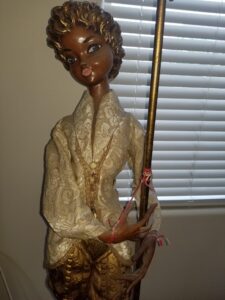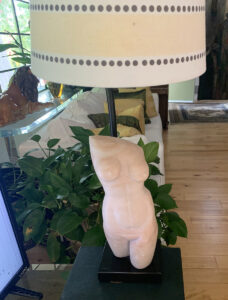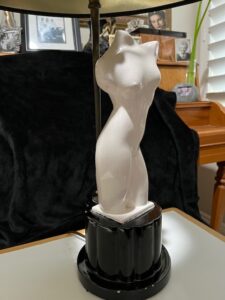 What one object personified KITSCH in a midcentury living room in the 1940s to early 1950’s? Those figural lamps that make us roll our eyes today, those non-politically correct, exotic sculptural lamps make us cringe. This article discusses cringeworthy midcentury table lamps that skate on the edge of tastelessness out to the borderland of the unimaginable.
What one object personified KITSCH in a midcentury living room in the 1940s to early 1950’s? Those figural lamps that make us roll our eyes today, those non-politically correct, exotic sculptural lamps make us cringe. This article discusses cringeworthy midcentury table lamps that skate on the edge of tastelessness out to the borderland of the unimaginable.
Some of the great designers of the late 1940s and early 1950s dabbled in lighting but wisely left the field to lesser geniuses. Those market savvy creators sold lamps to middleclass homeowners, a bunch of retail starved “sitting ducks”—they didn’t buy much during the clutch of the War years. Lamp creators felt free to become non-serious middle to lowbrow designers. They ran with themes, materials, and design elements considered NOVEL. In fact, novelty was the point! These figural lamps, exotic or nude themes, are often called novelty lighting fixtures.
Here’s list of a few types of “innovative”—a nice way to put it—mid-20th century lamps: the hanging chandelier with clear plastic thread holding tiny rivulets of oil drip, mimicking rain, the gaudy painted ceramic mallard duck on the wing with a lightbulb inside his body, wall mounted, or the Revolutionary War Minuteman whose rifle continues to support the shade shaped like a regimental drum, or the girl’s bedroom lamp with the automaton spinning ballerina in a bottle for the base. All eye-rollers.
Un-PC Pairs of Lamps
 A pair of identical or thematically matching lamps was important in this era as consumers admired proportion and balance. Pairs of lamps with figural themes became popular in the late 1940s into the 1950s, such as a pair of Chinese male and female Coolies, a matador proudly displaying a fantastic male physique and a anatomically correct bull, a pair of sinuous Balinese dancers, elbows akimbo, male and female, and, sadly, a cowboy and an ‘Indian,’ or a pair of exotic brown snake charmers, male and female, cross legged, their baskets containing a snake. Not to mention the nude female torso lamps of the era.
A pair of identical or thematically matching lamps was important in this era as consumers admired proportion and balance. Pairs of lamps with figural themes became popular in the late 1940s into the 1950s, such as a pair of Chinese male and female Coolies, a matador proudly displaying a fantastic male physique and a anatomically correct bull, a pair of sinuous Balinese dancers, elbows akimbo, male and female, and, sadly, a cowboy and an ‘Indian,’ or a pair of exotic brown snake charmers, male and female, cross legged, their baskets containing a snake. Not to mention the nude female torso lamps of the era.
A client sent me photos of naked Classical female Greek or Roman themed lamps that skate close to the edge of head shaking. Due to the fact that they stay clear of running the electrical wiring pole though the figure and into the neck of a nude female torso, I give these lamps a greenlight and call them semi artistic. Many such Grecian Style nude figural lamps have the pole sticking through the neck which negates any pleasing sculptural beauty. Should you believe a light fixture resembling a white Greek Classical sculpture is beautiful, you also expect the lamp to be an novelty in its day. Novelty became a marketing tool. Classical Greece and Rome were in fact popular as design motifs in the 1940s, early 1950s.
Yasha Heifetz
 The pair of lamps, of which one is pictured, are highly glazed white ceramic on black mock-columnar bases. The color scheme is emblematic of the change in the late 1940s design from the Deco (black and white) to the Modern pastel colors. The shape is unguent, slightly biomorphic, and surreal. The shape gives a nod to highbrow Grecian art. The nude Classical torso leads me to suspect the designer is Yasha Heifetz. When I first saw his name I thought—boy, and he played a mean violin as well. But this is Yasha and the violist is Jasha.
The pair of lamps, of which one is pictured, are highly glazed white ceramic on black mock-columnar bases. The color scheme is emblematic of the change in the late 1940s design from the Deco (black and white) to the Modern pastel colors. The shape is unguent, slightly biomorphic, and surreal. The shape gives a nod to highbrow Grecian art. The nude Classical torso leads me to suspect the designer is Yasha Heifetz. When I first saw his name I thought—boy, and he played a mean violin as well. But this is Yasha and the violist is Jasha.
Particular lamps designed by the (un-musical) Heifetz are coveted today. Yasha, a clever wood craftsman, made his nude figural shapes in wood, in pairs for lamp bases straight out of his woodworking studio. He kept his factory and studio in Connecticut, but opened his showroom in Manhattan in 1938. For approximately 25 years he created 4,000 unique lamp designs and some furniture and decorative art. His career got off to a legitimately highbrow designer’s start because he won the Museum of Modern Art’s Award for lighting design 1950-1 with ten of his table lamps. These go for big bucks today, created in wood, bronze, ceramic, and hammered brass. Then he needed to make money, and sell, so novelty became the guiding light.
His Plastic Ceiling Lamps Also Coveted and Pricey
He used spun acetate for hanging fixtures in spaceship and flying saucer forms, two toned. He called this style Rotoflex, similar, if not a snatch and grab, to those from the highly respected British design collaborative team of Sylvia and John Reid. The Reids, architects, furniture designers, and design consultants, called their spun acetate hanging fixtures Rotaflex, and are in the permanent collection of the Vicotria and Albert Museum.
Heifetz’ vintage spaceship style chandeliers sell upwards of $8,000 as they are sleek, geometric, and NOT kitschy. Pairs of “novelty” figural table lamps of his, however, unless they’re his carved wood biomorphic or cubist nudes, sell for $1,500 the pair or under.